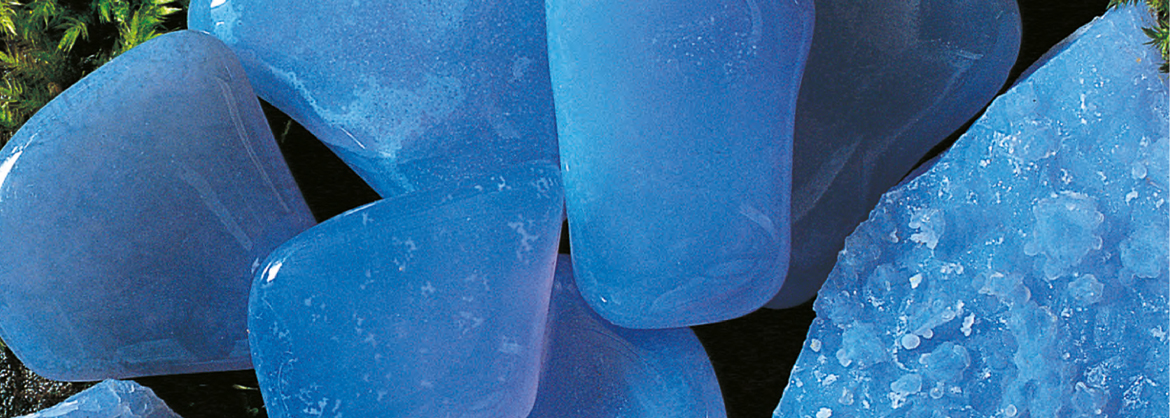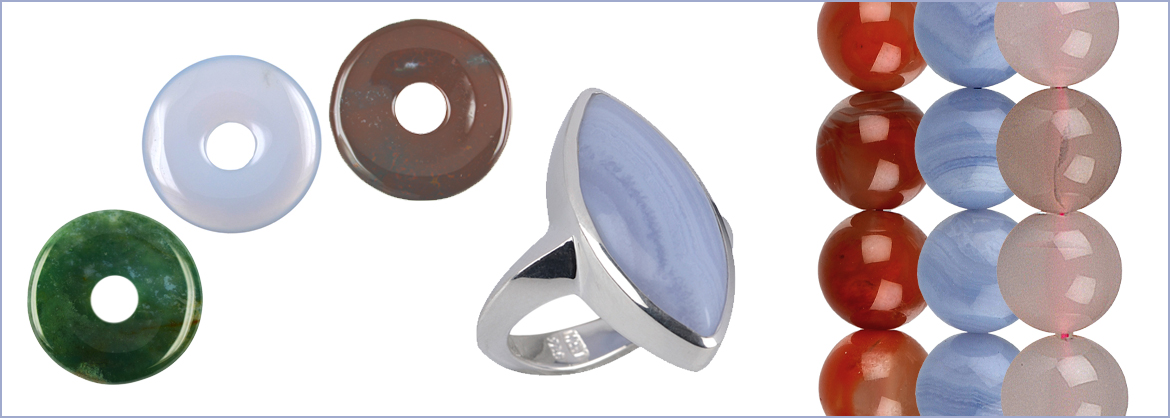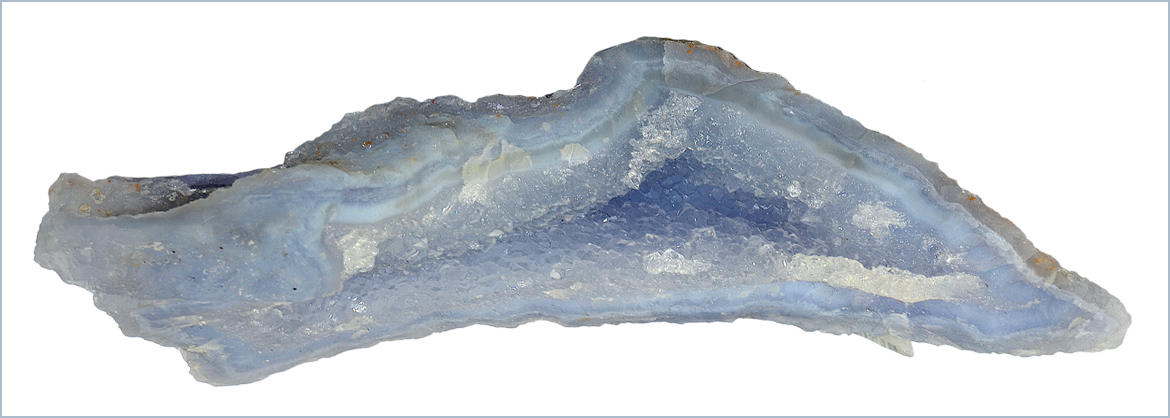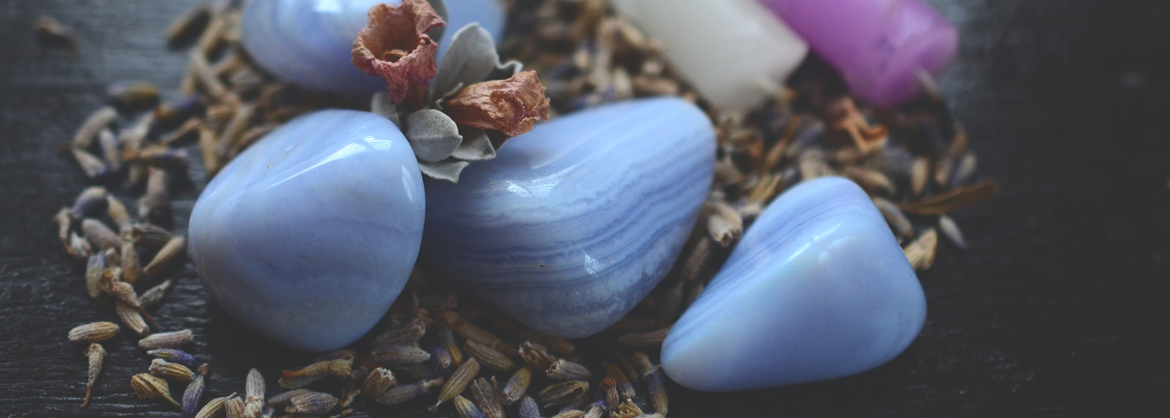
Blue Lace Agate and Chalcedony - Meaning and Effect
Chalcedon supports in this time of unfolding to communicate openly and full of understanding with our fellow human beings. Thanks to the "speech stone" we can listen relaxed, but still full of attention, understand and present our own position. New situations are more easily accepted and also the presence of mind is strengthened.
.
Tumbled Stones, donuts, chain strands and more items made of Chalcedony for can be found here in our online shop
Origin of the name Chalcedony
The Greek city of Kalchedon on the Bosporus or Carthage (Karchedon) are the eponym for Chalcedony. The term "chalcedon" was first used as a collective name for red minerals and was probably only since the 13th century occupied with the today valid definition of the mineral. However, the name did not become widely established until the 18th century, resulting in many old synonyms over the centuries such as cathedonian, pseudoquartzine, Swallowstone, Beekite, Sapphirite, Zoesite, Jasponyx, Quartzite, Jenzschite, Calcedony, Lutecine, Massic, Staarstone, Milkystone, Rednerstone, and Myrickite. Trade names include blue Moonstone and California Moonstone.

Mineralogical properties of chalcedony
Chemical formula: SiO2.
Mineral Class: oxide, quartz group.
Evolution: formed as lining of cavities at low temperature, near surface as stalactites and pseudomorphs.
Color: bluish, white-gray, also pinkish, reddish or red, green, brown.
Gloss: silk gloss or matte.
Crystal system: trigonal
Moh hardness: 6.5 to 7
Splitability: no splitability, conchoidal fracture, uneven, stale.
Appearance: dense homogeneous aggregates, partially banded, kidney
Occurrences, main supplying countries of chalcedony
The most important finding places of the blue chalcedony are in Brazil, India, Namibia, Turkey, South Africa, Mozambique as well as Russia.
Most of the commercial blue chalcedony came from Namibia. However, this deposit is now finally exhausted, as the several hundred meters high cap rock above the deposit would have to be removed and this is currently not economical economical. All articles made of this stone from this deposit are therefore stock items that can no longer be procured. However, through worldwide relationships, we have been able to secure corresponding raw materials in limited quantities and will gradually be able to offer you appropriate products from it. The blue chalcedony now available on the market is mainly from Turkey and Malawi, but it does not show the well-known banding and the chalcedony layers are much thinner. Therefore, at the moment only small Stone parts are cut from it such as Tumbled Stone or small pendants.

Use and application of chacledony in gemstone healing
Chalcedony is a classic jewelry stone and serves as a material for cameos, gems, ring stones, seal stones and many other jewelry and utility items. He is processed for a very long time and is therefore also often antiques. Large pieces are also material for columns and other architectural decorations as well as table tops and vases. In ancient times, chalcedony was used for weather spells and to cure weather-related illnesses. Blue Chalcedony is the typical stone for communication, therefore also known as "orator stone". As a chakra stone for the neck, it is used in chakra sets.
The astrology uses chalcedony to bring inspiration to Gemini-born, diplomacy to Scorpio-born, and insight to Sagittarius-born.
The Colors of chalcedony
The most famous chalcedony is the blue lace agate from South Africa, but in stone healing also pink chalcedony, green chalcedony and red blood chalcedony are valued.
The blue chalcedony from South Africa is a very interesting and rare material. Although chalcedony in itself is quite common, the blue stone is found in only a few locations. The color is usually a clear, pure sky blue, often with streaks. The color is caused by tiny enclosed fibers from other minerals. These scatter the light in a very special way, so that only the blue light is reflected out of the stone, while other colors (especially the red part) are absorbed. This special feature of the blue chalcedony was discovered by the Irish physicist John Tyndall. In his honor, this behavior is called "Tyndall effect". So the color is not caused by foreign substances as so often with other minerals, but only by the light refraction effect at finest lamellae.
You can find donuts, chain strands and other items made of chalcedony here in our online shop

Chalcedones, along with jasper, belong to one of the large quartz families, which includes many different minerals such as Sardonyx, Chrysoprase, Carnelian, Sard, Moss Agate, Agate and Onyx. Their microcrystalline, fibrous, radial-rayed structure is typical. Chalcedony is formed primarily or secondarily from aqueous silica solutions at temperatures below 100°C. It is found as gangue, fissure or cavity fillings in sediments, magmatites and metamorphic rocks. If the solution is in motion during hardening, it shows a typical it shows a typical banding, while at rest it is uniformly transparent. Chalcedony Rosettes can form at hot springs, which may resemble flowers, plants or organs. Foreign substances and trace elements are responsible for the many colors of the chalcedony family. the chalcedony family. The crystals are not visible to the naked eye. Chalcedony can very rarely also have an iridescent color play, Hematite inclusions or Pyrite inclusions.
Here you can find Tumbled Stones, jewelry and other items made of Chalcedony for resellers